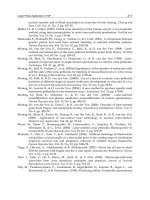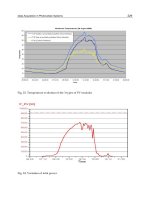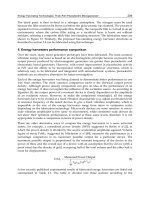Heat and Mass Transfer Modeling and Simulation Part 12 potx
Bạn đang xem bản rút gọn của tài liệu. Xem và tải ngay bản đầy đủ của tài liệu tại đây (687.97 KB, 6 trang )
Nonequilibrium Fluctuations in Micro-MHD Effects on Electrodeposition
211
2
j
for j = r or f (58)
where as will be discussed later, subscripts ‘r’ and ‘f’ imply rigid and free surfaces,
respectively. The signs ‘+’ and ‘-‘ are taken for the clockwise and counterclockwise rotations
corresponding to the signs of the z-component of the vorticity
jz
, respectively when
seeing the solution from electrode side. Then, it follows that
*
m
m
L
R
D
(59)
0
a and
1
a are arbitrary coefficients.
4.1 Formation of micro-mystery circle
4.1.1 Occurrence of chirality
As discussed initially, micro-mystery circle is treated as a 2D nucleus arising from
asymmetrical fluctuations. For asymmetrical fluctuation, as discussed in the former sections,
due to much larger scale of length of asymmetrical fluctuation than that of symmetrical
fluctuation, not nucleation process on the electrode but electrochemical process in the
electric double layer controls the total reaction. Therefore, the same amplitude equations as
Eqs. (49a) and (49b) are derived. The unstable condition for the micro-mystery circle
formation is also the same as Eq. (49c), which means that the micro-mystery circle formation
in a vertical magnetic field follows the same unstable condition as the secondary nodule
formation in a parallel magnetic field. Namely, when proton adsorption occurs, micro-
mystery circle is self-organized.
However, the equations of the coefficients
0
a and
1
a are different from the same kind of
equation Eq. (50a). Substituting for
0
0,
r
Dt and
0
0,
r
t from Eqs. (55a) and (55b) in Eq.
(49a), we have the coefficient equation for a rigid surface, i.e.,
1
1
a
aa
r
da
Af ka
dt
(60a)
and
6
5*
128
128 3
a
r
a
r
k
fk
k
(60b)
where
**aaa
rmmr
zFDSTR
(60c)
a
S
,
a
r
T
and
*
R
are the parameters expressing magnetic field, rotation and mass transfer,
respectively. Here,
*
R
is positive in Eq. (59). To avoid the singular point of k in Eq. (60b), the
condition
a
S
a
r
T
> 0 (61)
Heat and Mass Transfer – Modeling and Simulation
212
is required. For the external magnetic flux density defined by
0
B > 0,
a
S is also positive in
Eq. ( 57). In view of Eq. (58),
a
r
T must be thus positive, being defined by
2
a
r
(62)
Since
is the angular velocity of the rotation of the system, and assumed to be positive,
i.e., clockwise, the + sign indicates that the micro-MHD flow on a rigid surface rotates
clockwise, i.e., in the same direction as that of the system, i.e.,
a
r
w < 0 and
a
rz
> 0.
For a free surface, substituting for
0
0,
f
Dt and
0
0,
f
t from Eqs. (56a) and (56b) in Eq.
(49a), we get
0
0
a
aa
f
da
A
f
ka
dt
(63a)
where
6
5*
96
96 5
a
f
a
f
k
fk
k
(63b)
where
**aaa
fmmf
zFDSTR
(63c)
Since
*
R is, as discussed above, positive. In order to avoid the singular point of k in Eq.
(63b), the condition
a
S
a
f
T < 0 (64)
is required. Since
a
S is positive,
2
a
f
< 0 (65)
must be fulfilled. In comparison with Eq. (62), Eq. (65) indicates that the micro-MHD
vortexes on a free surface rotates in the direction reverse to that of the vortexes on a rigid
surface, i.e.,
a
f
w > 0 and
a
fz
< 0.
4.1.2 Formation of micro-mystery circle
To treat the two independent self-organization processes concerning rigid and free
surfaces at one time, it is necessary to describe the amplitudes in complex numbers. In
Fourier inversion, utilizing the characteristic nature of complex Fourier transform, where
even and odd functions are simultaneously transformed in the real and imaginary parts,
we treat the rigid surface and free surface components as even and odd functions,
respectively.
In consideration of the stochastic process in multiple nucleus formation, the following unit
complex number is introduced.
Nonequilibrium Fluctuations in Micro-MHD Effects on Electrodeposition
213
cos sin
aa a
d rand rand
Ri
(66)
where
a
rand
is the uniform random number between 0 and 2
, which are assigned to all
grid points defined in an electrolyte solution. From the amplitudes of the gradients of the
concentration fluctuations, the actual concentration gradients are calculated by Fourier
inversion as follows,
0
,,,
mj
z
cxyzt
z
=
0
1
,exp
2
a
j
x
y
x
y
D z t i k x k y dk dk
for j = r or f (67)
where
22
1
0
12
0, exp
2
5
aa
a
r
a
rd
a
mmr
fka
ak
Dt R
zFDS
(68a)
and
1/2
*
1
5
12
aa a
rmmr
XY
zFD S
(68b)
Then, we have
22
0
0
12
0, exp
2
5
aa
af
a
fd
a
mmf
fka
ak
Dt R
zFDS
(69a)
where
1/2
*
0
5
12
aa a
f
mm
f
XY
zFD S
(69b)
As discussed initially, to automatically determine the rigid and free areas, the signs of the
z-components of the velocity
a
j
w and vorticity
a
z
j
for j =r or f are important. The actual
z-components of velocity and vorticity fluctuations are calculated by the Fourier inversions.
For a clockwise rotating system, under the conditions
a
r
w < 0 and
a
zr
> 0, the current
density on the rigid surface is calculated by
,,0,
a
zr m m
jxyt zFD
0
,,,
mr
z
cxyzt
z
(70a)
Under the conditions
a
f
w > 0 and
a
z
f
< 0, the current density on the free surface is given
by
,,0,
a
z
f
mm
jxyt zFD
0
,,,
mf
z
cxyzt
z
(70b)
Heat and Mass Transfer – Modeling and Simulation
214
The total current density
,,0,
a
z
j
x
y
t
is thus expressed by
,,0,
a
z
j
x
y
t =
,,0,
a
zr
jxyt +
,,0,
f
a
z
j
x
y
t (70c)
As a result, the surface morphology of the 2D nucleation is effectively calculated by
,,
a
x
y
t
=
0
,,0,
a
t
m
z
m
j
x
y
tdt
zF
(71)
In this calculation, only 1/4th of the total fluctuations is used at one time. This inadequacy is
solved by multiple nucleus formation randomly occurring in time axis.
In Fig. 20a, an example of the theoretical calculation is exhibited. Owing to multiple random
nucleus formation, though nucleation takes place all over the surface, four regular micro-
mystery circles emerge. Figure 20b represents the 3D SEM image of a micro-mystery circle
formed in copper deposition, which was observed in a rotating electrode system under a
vertical magnetic field.
20 μm
b a
Fig. 20. Morphology of micro-mystery circle. a, theoretical calculated morphology;
b, SEM image of copper micro-mystery circle in copper deposition of the rotating system.
4.2 Formation of nano-mystery circle
As have been discussed in last section, at the boundary on a free surface of 2D nucleus covered
with ionic vacancies, the frictionless rotation of vortex reverse to the rotating system yields a
concentric circular pattern of micro-mystery circle, whereas at the boundary on the rigid
surface, due to friction, the solution is kept stationary. 3D nucleus formation on a rigid surface
of 2D nucleus also receives the same effects as 2D nuclei, i.e., the precession to micro-MHD
flows and the selection of the direction of rotation. However, there are some differences; due to
small scale of length, i.e., low Reynolds number, the effective viscosity that vortexes feel
becomes too high to rotate, so that rotations themselves become impossible. To solve this
problem, a new effect of ionic vacancy to decrease viscosity is required.
Considering that ionic vacancies are easy to coalesce from a nature of bubble, we propose a
new effect called ‘micro-hydroplaning’. Due to coalescence, ionic vacancies are supposed to
act like a creamy lubricant. Let us imagine a coffee surface with cream, where due to the
difference of viscosity, without mixing, the cream forms white stripes surrounding coffee
vortexes. If these stripes are replaced with those of ionic vacancies, just like a wheel in the
Nonequilibrium Fluctuations in Micro-MHD Effects on Electrodeposition
215
well-known hydroplaning effect, a micro-vortex surrounded by the stripes of ionic
vacancies can rotate freely. This phenomenon effectively decreases kinematic viscosity.
Since ionic vacancies gather in an upward flow of a 3D nucleus, according to this effect, the
local kinematic viscosity in the upward flow drastically decreases for rotation. As a result, in
the downward flow without ionic vacancy, due to effectively high viscosity, the rotation
itself is prohibited, remaining stationary, whereas in the upward flow containing the stripes
of ionic viscosity, owing to effectively low viscosity, a vortex can rotate. In the same way as
that of the micro-mystery circle formation, but quite different in size, a concentric circular
pattern called nano-mystery circle with chirality is thus formed. At the center of the nano-
mystery circle, a screw dislocation with chirality emerges. In Fig. 21a, the theoretical
calculation of nano-mystery circle is represented. In spite of random multiple nucleus
formation, nano-mystery circles can be seen. Figure 21b shows the SEM image of a copper
deposit, where many shallow dimples in the same shape are observed.
ba
Fig. 21. Morphology of nano-mystery circle. a, theoretical calculation (2 μm in full scale);
b, SEM image ofcopper nano-mystery circle in copper deposition of the rotating system
(4 μm in full scale).
5. Conclusion
In a parallel magnetic field, usually an electrode system called MHD electrode is used,
which consists of a rectangular channel with two open ends (Fig. 1). Arriving through the
inlet, the solution moves along the electrode surface, and leaves out of the outlet. As a result,
generated vacancies are continuously swept away from the electrode surface. This is the
reason why the vacancy does not affect the deposition process in a parallel magnetic field.
6. References
Aogaki, R., Fueki, K., & Mukaibo, T. (1975). Application of Magnetohydrodynamic Effect to
the Analysis of Electrochemical Reactions –2. Diffusion Process in MHD Forced
Flow of Electrolyte Solutions.
DENKI KAGAKU (presently Electrochemistry), Vol. 43,
No. 9, (August 1975), pp. 509-514, ISSN 1344-3542
Aogaki, R., Kitazawa, K., Kose, Y., & Fueki, K. (1980). Theory of Powdered Crystal
Formation in Electrocrystallization -Occurrence of Morphological Instability at the
Electrode Surface.
Electrochimica Acta, Vol. 25, No. 7, (July 1980), pp. 965-972, ISSN
0013-4686
Heat and Mass Transfer – Modeling and Simulation
216
Aogaki, R. (1995). Instability of Nonequilibrium Fluctuation in Electrochemical Nucleation I.
Occurrence of Instability. Journal of Chemical Physics, Vol. 103, No. 19, (November
1995), pp. 8602-8615, ISSN 0021-9606
Aogaki, R. (2001). Magnetic Field Effects in Electrochemistry.
Magnetohydrodynamics, Vol. 37,
No. 1/2, (August 2001), pp. 143-150, ISSN 0024-998X
Aogaki, R., Morimoto, R., Sugiyama, A., & Asanuma, M. (2008a). Self-organization of
Copper Secondary Nodules by the Second Micro-MHD Effect.
ECS Transactions,
Vol. 13, No. 16, (December 2008), pp. 15-24, ISSN 1938-6737
Aogaki, R. (2008b). Theory of Stable Formation of Ionic Vacancy in a Liquid Solution.
Electrochemistry, Vol. 76, No. 7, (June 2008), pp. 458-465, ISSN 1344-3542
Aogaki, R., Morimoto, R., Sugiyama, A., & Asanuma, M. (2009a). Double Layer Mechanism
in Self-organization of Copper Secondary Nodules under a Parallel Magnetic Field.
Magnetohydrodynamics, Vol. 45, No. 2, (April 2009), pp. 245-252, ISSN 0024-998X
Aogaki, R., Miura, M., & Oshikiri, Y. (2009b). Origin of Nanobubble-Formation of Stable
Vacancy in Electrolyte Solution.
ECS Transactions, Vol. 16, No. 25, (May 2009), pp.
181-189, ISSN 1938-6737
Aogaki, R., Morimoto, R., Sugiyama, A., & Asanuma, M. (2009c). Origin of chirality in
magnetoelectrodeposition,
Proceedings of 6th International Conference Electromagnetic
Processing of Materials
, pp. 439-442, ISBN 978-3-936104-65-3, Dresden, Germany,
October 2009
Aogaki, R., Morimoto, R., & Asanuma, M. (2010). Nonequilibrium Fluctuations in Micro-
MHD Effects on Electrodeposition.
Journal of Magnetism and Magnetic Materials, Vol.
322, No. 9/12, (June 2010), pp. 1664-1668, ISSN 0304-8853
Mogi, I., & Watanabe, K. (2005). Chirality of magnetoelectropolymerized polyaniline
electrodes.
Japan Journal of Applied Physics, Vol. 44, No. 5, (January 2005), pp. L199-
L201, ISSN 0021-4922
Mogi, I. (2008). Chiral Electrode Behaviors of Magnetoelecrodeposited Ag films for Amino
Acids.
ECS Transactions, Vol. 13, No. 16, (December 2008), pp. 45-52, ISSN 1938-
6737
Sugiyama, A., Morimoto, R., Hashiride, M., Nagai, Y., & Aogaki, R. (2004). Application of
Vertical Micro-disk MHD electrode to the Analysis of Heterogeneous Magneto-
convection.
Electrochimica Acta, Vol. 49, No. 28, (November 2004), pp. 5115-5124,
ISSN 0013-4686
Morimoto, R., Sugiyama, A., & Aogaki, R. (2004). Nano-scale Crystal Formation in Copper
Magneto-electrodeposition Under Parallel Magnetic Fields.
Electrochemistry, Vol. 72,
No. 6, (May 2004), pp. 421-423, ISSN 1344-3542
Morimoto, R., Aogaki, R., Sugiyama, A., & Asanuma, M. (n.d-a). Micro-MHD Effects in a
Parallel Magnetic Fields -1. Equations of Micro-MHD Flows. in the course of
submission to J. Chem. Phys.
Morimoto, R., Aogaki, R., Sugiyama, A., & Asanuma, M. (n.d-b). Micro-MHD Effects in a
Parallel Magnetic Fields -2. 1
st
Micro-MHD Effect: Suppression of Three
Dimensional (3D) Nucleation. in the course of submission to J. Chem. Phys.









